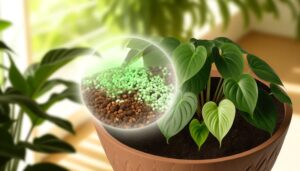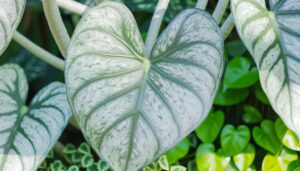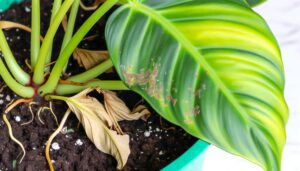What Is the Scientific Name of Heartleaf Philodendron?
The Heartleaf Philodendron, often cultivated for its attractive, glossy heart-shaped leaves, is scientifically known as Philodendron hederaceum. This species, belonging to the family Araceae, exhibits a climbing growth habit and is native to Central and South America.
Philodendron hederaceum is adapted to thrive in low-light conditions and is resilient against common pests and diseases. The classification and nomenclature follow the International Code of Nomenclature for algae, fungi, and plants, ensuring precision and uniformity in plant identification.
For more details on its unique characteristics and care requirements, the subsequent sections offer further insights.
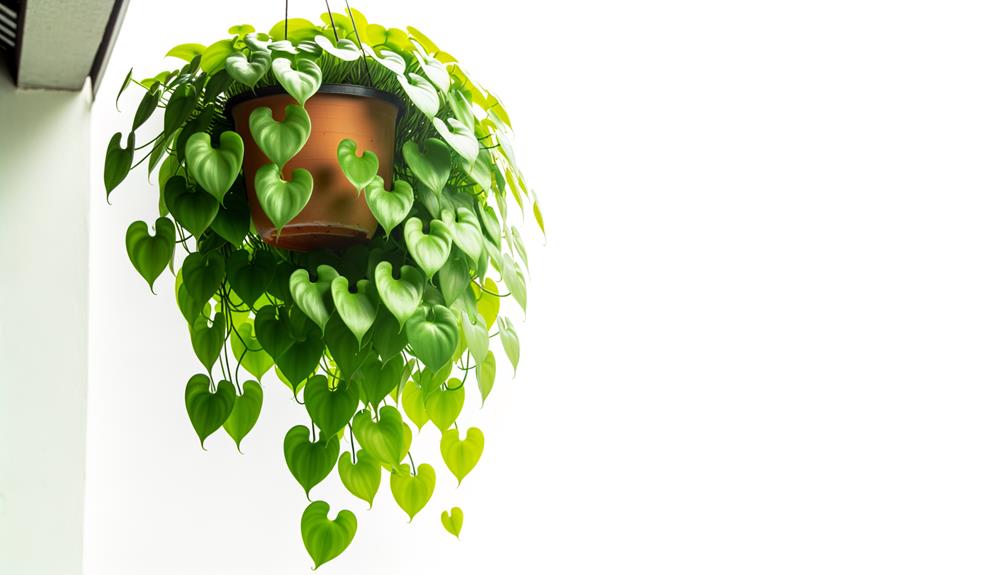
Key Takeaways
- The scientific name of Heartleaf Philodendron is *Philodendron hederaceum*.
- It belongs to the family Araceae and the genus Philodendron.
- The species epithet "hederaceum" reflects its ivy-like appearance.
- *Philodendron hederaceum* is known for its heart-shaped, glossy leaves.
- The name facilitates precise identification and classification within the botanical hierarchy.
Overview of Heartleaf Philodendron
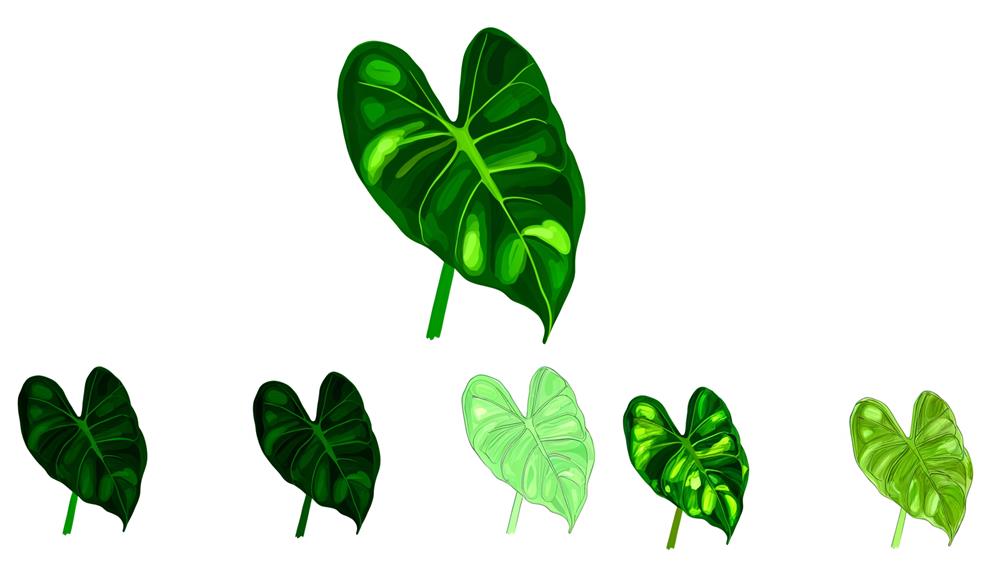
The Heartleaf Philodendron (Philodendron hederaceum) is a popular, evergreen houseplant known for its heart-shaped, glossy leaves and its ability to thrive in low-light conditions.
Indigenous to the tropical regions of Central and South America, this perennial vine exhibits a climbing growth habit, often utilizing aerial roots to adhere to supports. The leaves, typically dark green and ranging from 2 to 4 inches in length, are characterized by their smooth, leathery texture and prominent venation.
The plant's adaptability to various environmental conditions, including low humidity and indirect light, makes it a preferred choice for indoor cultivation.
Additionally, Philodendron hederaceum demonstrates resilience against common pests and diseases, further contributing to its popularity among houseplant enthusiasts.
Historical Background
Recognized today for its ornamental value, Philodendron hederaceum has a rich historical background rooted in its discovery and classification during botanical explorations of the 19th century.
European botanists, fascinated by the biodiversity of tropical regions, first encountered this species in the dense rainforests of Central and South America. Philodendron hederaceum, often referred to as the Heartleaf Philodendron, was meticulously documented for its distinctive heart-shaped leaves and climbing growth habit.
This species was subsequently introduced to Europe, where it gained popularity as a houseplant. Early botanical literature, such as that by Heinrich Wilhelm Schott, contributed to its formal classification within the Araceae family.
The plant's adaptability and aesthetic appeal have solidified its status in both historical and modern botanical contexts.
Botanical Nomenclature Basics

Botanical nomenclature, the systematic naming of plant species, relies on standardized conventions established by the International Code of Nomenclature for algae, fungi, and plants (ICN).
This code guarantees that each plant species is assigned a unique, universally accepted scientific name in Latin. The scientific name, or binomial nomenclature, consists of two parts: the genus name, which is capitalized, and the specific epithet, which is not. For example, in *Philodendron hederaceum*, *Philodendron* denotes the genus and *hederaceum* specifies the species.
Additionally, the name must be accompanied by a description or diagnosis written in Latin, ensuring accuracy and universal comprehension. This system facilitates precise communication and categorization across botanical disciplines, minimizing confusion in plant identification and study.
Scientific Classification
Understanding the scientific classification of a plant further refines its identification by placing it within a hierarchical structure that includes the family, order, class, and other taxonomic ranks.
The Heartleaf Philodendron, scientifically named *Philodendron hederaceum*, belongs to the family Araceae, known for its monocotyledonous flowering plants. Its order, Alismatales, encompasses aquatic and terrestrial species. The class Liliopsida, which includes monocots, reflects the plant's structure featuring parallel-veined leaves.
Within the division Magnoliophyta, the Heartleaf Philodendron is classified among flowering plants, or angiosperms. This hierarchical system aids botanists and horticulturists in understanding the plant's evolutionary relationships, ecological roles, and physical characteristics, providing a detailed framework for accurate identification and study.
Genus: Philodendron
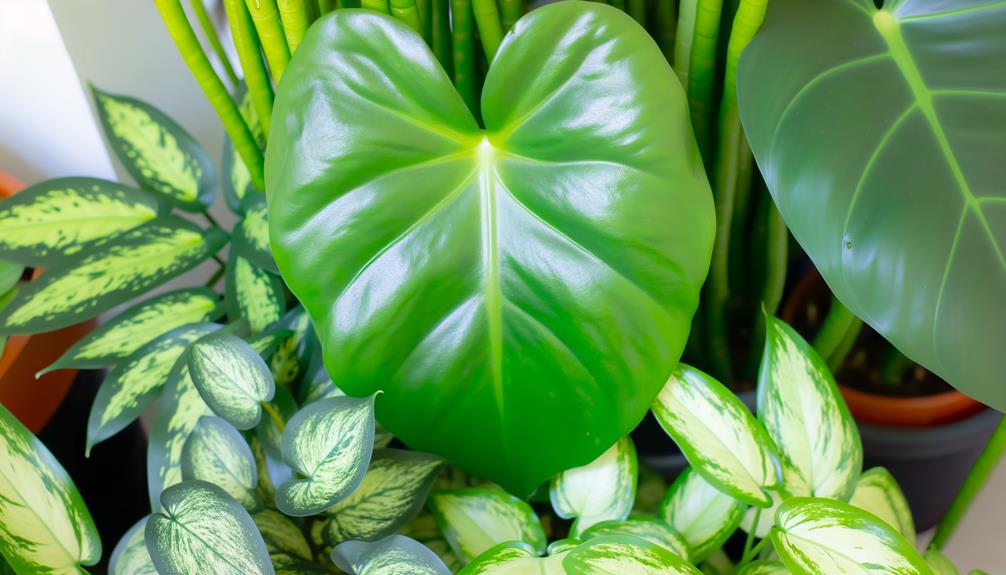
Encompassing a diverse range of species, the genus *Philodendron* is notable for its climbing and non-climbing forms, often characterized by their large, lobed leaves and epiphytic growth habits. These plants, native to tropical regions of the Americas, exemplify adaptability and morphological variety. Members of this genus exhibit a unique aroid inflorescence and thrive in humid, low-light environments. The following table highlights key characteristics:
| Feature | Description |
|---|---|
| Leaf Shape | Heart-shaped, lobed, or deeply cut |
| Growth Form | Climbing (vining) or self-heading (non-climbing) |
| Native Habitat | Tropical rainforests |
| Inflorescence Type | Spadix surrounded by a spathe |
| Epiphytic Growth | Often grows on other plants or trees |
Through these features, *Philodendron* species are highly valued in both horticulture and ecological studies.
Species: Hederaceum
Philodendron hederaceum, commonly known as the Heartleaf Philodendron, exhibits distinctive cordate leaves with a glossy, deep green surface.
This species thrives in indirect light and well-draining soil, demonstrating vigorous growth in tropical and subtropical climates.
Effective care involves maintaining consistent moisture levels and providing occasional nutrient supplementation.
Identification and Characteristics
Heartleaf Philodendron (Philodendron hederaceum) is characterized by its cordate, glossy leaves that typically measure between 5 to 10 centimeters in length, displaying a vibrant green hue.
The leaves emerge from slender, flexible stems that can climb or trail, making the plant versatile in both hanging baskets and as a groundcover.
Philodendron hederaceum is a member of the Araceae family and exhibits a hemiepiphytic growth habit, meaning it can grow both on other plants and in soil. The plant's aerial roots facilitate nutrient absorption and provide structural support in its natural habitat.
Leaf morphology includes a smooth texture with prominent venation, enhancing its ornamental appeal. This species is often used in interior landscaping due to its adaptability and aesthetic foliage.
Growth and Care
To maximize growth and health for Philodendron hederaceum, it is essential to provide a humid environment with indirect light and well-draining soil. Best humidity levels should be maintained between 60-80%.
Light should be filtered or diffused to mimic the plant's native understory habitat, preventing leaf scorch. A soil mixture rich in organic matter with components such as peat, perlite, and orchid bark guarantees proper aeration and drainage.
Watering should be consistent yet moderate, allowing the top inch of soil to dry between waterings. Fertilization with a balanced, water-soluble fertilizer at half-strength monthly during the growing season supports robust growth.
Pruning encourages bushier growth and prevents legginess, ensuring a healthy, vibrant specimen.
Naming Authority

The naming authority for the Heartleaf Philodendron, officially recognized as Philodendron hederaceum, lies within the purview of established botanical classification systems.
Taxonomic naming principles, governed by the International Code of Nomenclature for algae, fungi, and plants (ICN), guarantee the accurate and consistent application of Latin binomials.
This standardized approach supports clear communication and proper identification within the scientific community.
Botanical Classification Authority
Botanical classification authority for Philodendron hederaceum, commonly known as the Heartleaf Philodendron, is attributed to the renowned taxonomist Heinrich Wilhelm Schott.
Schott, an eminent Austrian botanist of the 19th century, made significant contributions to the taxonomy of the Araceae family. His meticulous work in classifying aroids has been foundational, providing clarity and organization within this diverse group of plants.
Philodendron hederaceum, characterized by its heart-shaped leaves and climbing habit, falls under the genus Philodendron within the Araceae family. Schott's expertise in morphological characteristics and his systematic approach facilitated the precise identification and nomenclature of Philodendron species.
His legacy continues to influence contemporary botanical studies and the accurate classification of aroids.
Taxonomic Naming Principles
Understanding the taxonomic naming principles is pivotal to appreciating how Heinrich Wilhelm Schott's classification of *Philodendron hederaceum* adheres to the binomial nomenclature system established by Carl Linnaeus. This system guarantees that each species has a unique, universally recognized scientific name.
The genus name, *Philodendron*, identifies a broader group of related species, while the specific epithet, *hederaceum*, distinguishes this particular species within the genus.
Key principles include:
- Uniqueness: Each name is distinctive to a single species.
- Universality: Names are acknowledged worldwide.
- Stability: Names remain constant over time.
- Descriptiveness: Often provides information about the species' characteristics.
- Hierarchical Classification: Reflects evolutionary relationships.
These principles help maintain clarity, consistency, and communication in the scientific community.
Common Names
Several colloquial names exist for the Heartleaf Philodendron, including Sweetheart Plant and Philodendron Scandens. These common names often reflect the plant's appearance and growth habits.
The term 'Sweetheart Plant' arises from its distinctive heart-shaped leaves, which exhibit a lush, green hue and a glossy surface. 'Philodendron Scandens' is another frequently used name, derived from the plant's climbing nature, as 'scandens' means 'climbing' in Latin.
Additionally, this species is sometimes referred to as 'Parlor Ivy' due to its popularity as a low-maintenance houseplant suitable for indoor environments. The use of these common names highlights the plant's aesthetic and functional appeal, making it a favored choice among horticultural enthusiasts and indoor plant aficionados.
Importance of Scientific Names
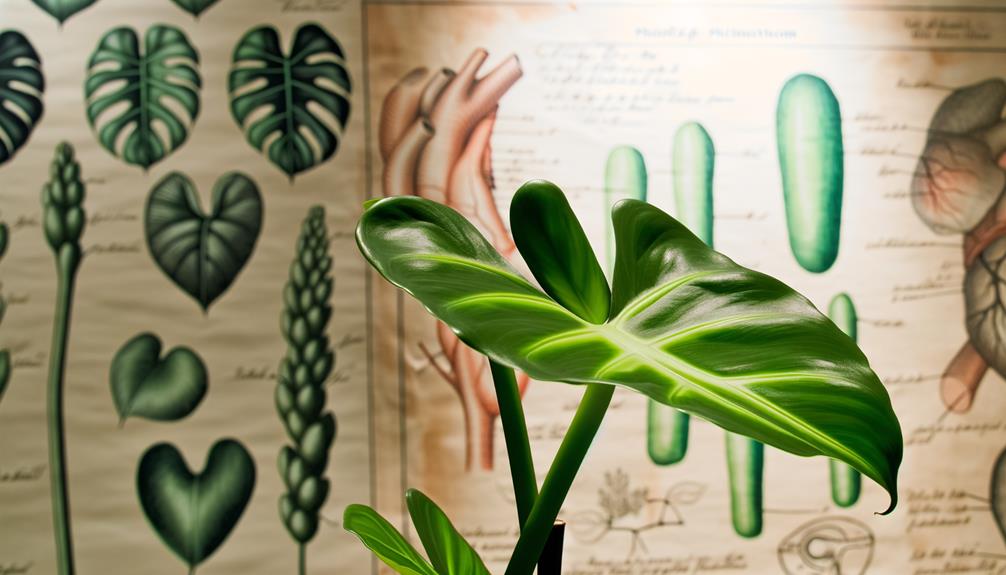
The scientific name, Philodendron hederaceum, provides a precise and universally accepted identification for the Heartleaf Philodendron, eliminating confusion caused by its various common names.
Scientific nomenclature is important for several reasons:
- Consistency: Guarantees uniformity across different languages and regions.
- Classification: Eases accurate placement within the botanical hierarchy.
- Communication: Enhances clarity in scientific discourse and research.
- Identification: Assists in the precise recognition of species, reducing errors.
- Conservation: Helps in the conservation efforts by clearly identifying species at risk.
Understanding and using scientific names, such as Philodendron hederaceum, is vital for botanists, horticulturists, and plant enthusiasts, ensuring clear and effective communication in the global scientific community.
Identification Features
Characterized by its unique heart-shaped leaves, Philodendron hederaceum displays a vibrant green hue and a sleek, shiny texture. The leaves, typically measuring between 7 to 15 cm in length, possess a pointed apex and a slightly undulating border. The petioles are slim and uphold the leaves, ensuring a graceful, cascading aesthetic. The plant's stems are pliant and can either climb or trail, offering versatility for various presentation choices. Significantly, the aerial roots assist in anchoring to surfaces, facilitating its climbing behavior.
| Feature | Description |
|---|---|
| Leaf Shape | Heart-shaped, pointed apex |
| Leaf Texture | Smooth, glossy |
| Leaf Size | 7 to 15 cm in length |
| Stem Type | Flexible, climbing or trailing |
| Petiole | Slim, supports leaves |
| Aerial Roots | Assist in attachment to surfaces |
These characteristics collectively pinpoint Philodendron hederaceum with accuracy.
Care and Maintenance
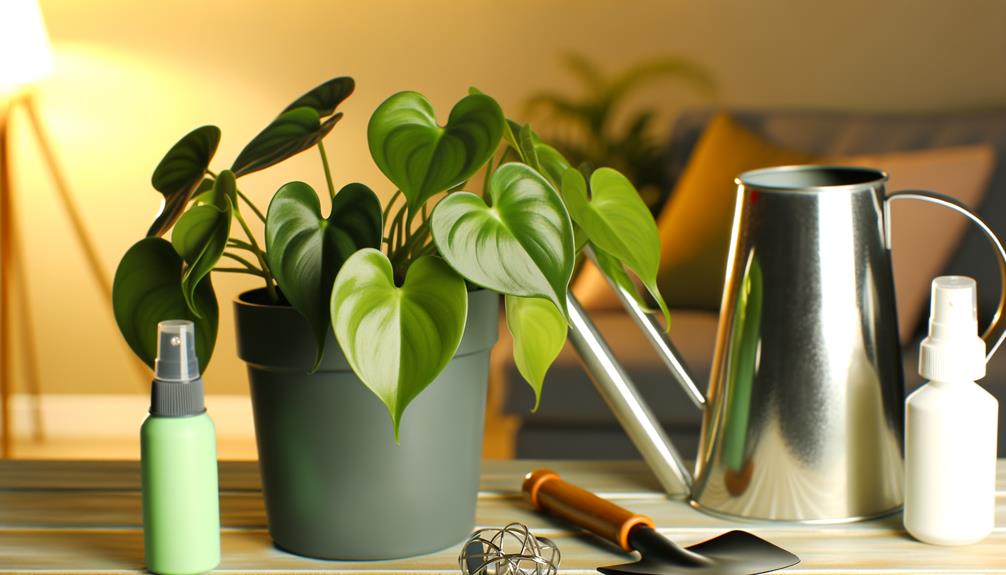
Proper care and maintenance of Philodendron hederaceum require attention to its specific watering and humidity needs, as well as its light and temperature requirements.
This species thrives in consistently moist, well-draining soil and benefits from high humidity environments.
Best growth is achieved under bright, indirect light and temperatures ranging between 18-26°C (65-80°F).
Watering and Humidity Needs
Maintaining ideal moisture levels for Philodendron hederaceum involves consistent watering practices and ensuring sufficient ambient moisture. This species thrives when its soil remains moderately damp but not waterlogged. Overwatering can lead to root rot, while underwatering can cause leaf wilting. Achieving the right balance is essential for best growth.
Key watering and moisture guidelines include:
- Watering Frequency: Water when the top inch of soil feels dry to the touch.
- Drainage: Guarantee the pot has adequate drainage to prevent standing water.
- Humidity: Maintain ambient moisture levels between 60-80%.
- Mist Leaves: Occasionally mist the leaves to increase moisture.
- Use of Humidifiers: Employ humidifiers in drier environments to sustain proper moisture levels.
Light and Temperature Requirements
Ensuring best light and temperature conditions for Philodendron hederaceum is vital for promoting healthy growth and vibrant foliage. Optimal lighting involves bright, indirect sunlight; direct exposure can cause leaf scorching. A north or east-facing window is ideal. The plant adapts to lower light, though this may slow growth.
Temperature requirements are equally important: Philodendron hederaceum thrives in temperatures ranging from 18°C to 27°C (65°F to 80°F). It is essential to avoid temperatures below 15°C (59°F), as prolonged exposure can induce stress and damage.
Humidity levels should be moderate to high, ideally above 50%, to mimic its native tropical environment. Consistent environmental conditions are key to maintaining the plant's health and aesthetic appeal.
Popular Varieties
Among the popular varieties of Heartleaf Philodendron, Philodendron hederaceum 'Brasil' and Philodendron hederaceum 'Micans' are particularly remarkable for their distinctive foliage and growth patterns.
Philodendron hederaceum 'Brasil' features striking variegated leaves with splashes of lime green and yellow, while Philodendron hederaceum 'Micans' boasts velvety, dark green leaves with a bronze tint. These varieties thrive in indirect light and adapt well to indoor environments.
Other notable varieties include:
- Philodendron hederaceum 'Lemon Lime': Bright, chartreuse leaves.
- Philodendron hederaceum 'Green': Classic, deep green foliage.
- Philodendron hederaceum 'Variegatum': Creamy white and green variegation.
- Philodendron hederaceum 'Aureum': Golden-yellow variegation.
- Philodendron hederaceum 'Silver': Silvery-green leaves with a metallic sheen.
Each offers unique aesthetic appeal and adaptability.
Conclusion
To sum up, Philodendron hederaceum, popularly known as the heartleaf philodendron, exemplifies the significance of precise botanical nomenclature and classification in plant identification and care.
Significantly, heartleaf philodendron can enhance indoor air quality by eliminating pollutants, with research showing a 60% decrease in formaldehyde levels in a controlled setting.
Such data highlight the importance of this species not just for its decorative appeal but also for its possible benefits to human health and well-being.



